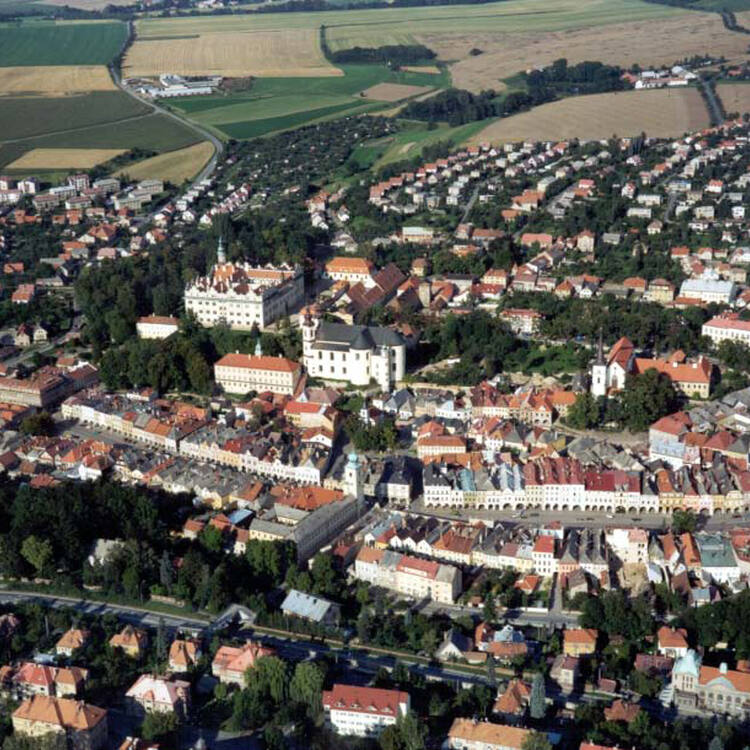Litomyšl Castle
Litomyšl Castle
Litomyšl Castle was originally a Renaissance arcade-castle of the type first developed in Italy and then adopted and greatly developed in central Europe in the 16th century. Its design and decoration are particularly fine, including the later High-Baroque features added in the 18th century. It preserves intact the range of ancillary buildings associated with an aristocratic residence of this type.
Description is available under license CC-BY-SA IGO 3.0
Château de Litomyšl
Le château de Litomyšl est à l'origine un château à arcades Renaissance, style qui a vu le jour en Italie et qui fut adopté et largement développé en Europe centrale au XVIe siècle. Sa conception et sa décoration sont de haute qualité, y compris les ajouts de style baroque-classique tardif du XVIIIe siècle. Le château a conservé la totalité des bâtiments annexes qui sont associés à ce type de demeure aristocratique.
Description is available under license CC-BY-SA IGO 3.0
قصر ليتوميشل
كان قصر ليتوميشل مزوداً بقناطر يعود طرازها الى عصر النهضة وهو طراز أبصر النور في ايطاليا واعتمد في اوروبا الوسطى حيث شهد تطوراً كبيراً في القرن السادس عشر. ويتميز تصميمه وزينته بمستوى رفيع بما في ذلك اضافات الطراز الباروكي الكلاسيكي الأخير في القرن الثامن عشر. وقد حافظ القصر على مجمل المباني الملحقة به والمنسجمة مع هذا النمط من المنازل الارستقراطية.
source: UNESCO/CPE
Description is available under license CC-BY-SA IGO 3.0
利托米什尔城堡
利托米什尔城堡承袭了文艺复兴时期拱廊式城堡的建筑风格。这种最早成形于意大利的建筑风格,在16世纪的中欧被广泛采纳并得以充分发展。其图案和装潢,包括18世纪增添的鼎盛巴洛克式晚期的装饰物,都堪称极品。这座拱廊风貌的贵族宅邸及其附属建筑都原封不动地保留了下来。
source: UNESCO/CPE
Description is available under license CC-BY-SA IGO 3.0
Замок в городе Литомишль
Замок в Литомишле был первоначально создан как «замок с аркадами». Эта модель получила развитие сначала в Италии, а затем, в XVI в., была принята и широко использовалась в Центральной Европе. Особенно прекрасны добавленные в XVIII в. архитектурные решения и декоративное оформление, включая появившиеся позднее элементы высокого барокко. Замок сохранил в целости ряд служебных зданий, свойственных аристократической резиденции такого типа.
source: UNESCO/CPE
Description is available under license CC-BY-SA IGO 3.0
Palacio de Litomyšl
El palacio de Litomyšl es un edificio con arquería inspirado en el estilo renacentista italiano, que fue adoptado y ampliamente desarrollado en Europa Central durante el siglo XVI. La magnificencia de su diseño y ornamentación es también característica de los elementos de estilo barroco-clásico tardío que fueron añadidos en el siglo XVIII. El castillo ha conservado la totalidad de los edificios anejos tradicionales en este tipo de mansiones aristocráticas.
source: UNESCO/CPE
Description is available under license CC-BY-SA IGO 3.0
リトミシュル城
リトミシュルは、チェコ東北部、ボヘミア地方の都市。リトミシュル城は、16世紀にボヘミアやモラヴィアをはじめ中央ヨーロッパに広まったルネサンス様式建築のなかでも、他に比類のない威容を誇る柱廊付きの城郭である。その設計と装飾はきわめて高度なものであり、後に18世紀のバロック様式の特徴も付け加えられた。またこの種の貴族の館に付随する一連の建築物も原形のまま残されている。source: NFUAJ
Kasteel Litomyšl
Litomyšl bestaat sinds de 10e eeuw, toen het een nederzetting was met een versterkte kern op de heuvel waar het kasteel nu staat. Kasteel Litomyšl was oorspronkelijk een Renaissance arcadekasteel, van het soort dat voor het eerst in Italië werd ontwikkeld en vervolgens werd overgenomen in Centraal-Europa in de 16e eeuw. Het ontwerp en de inrichting zijn erg mooi, waaronder de latere hoogbarokke kenmerken die toegevoegd werden in de 18e eeuw. Kasteel Litomyšl is een goed voorbeeld van de aristocratische residenties van Centraal-Europa tijdens de Renaissance en hun latere ontwikkeling onder invloed van nieuwe artistieke stromingen. De bijgebouwen van het aristocratisch kasteel zijn ook intact gebleven.
Source: unesco.nl
Outstanding Universal Value
Brief Synthesis
The Litomyšl Castle is an outstanding example of an arcaded Renaissance country residence, a type of structure first invented in Italy and then developed in the Czech Lands to create a mature form with special architectural value. Situated at an important communications junction on the main route between Bohemia and Moravia, in the Pardubice region, Litomyšl was a fortified centre on the hill where the castle now stands.
The work on the Renaissance building began in 1568 under the supervision of Jan Baptista Avostalis (Giovanni Battista Avostalli), who was soon joined by his brother Oldřich (Ulrico). Most of the work had been completed by 1580. The castle interior underwent alterations between 1792 and 1796, based on the designs of Jan Kryštof Habich, but he was careful to preserve the fine building’s Renaissance appearance with impressive gables.
The castle is a four-winged, three-storeyed structure with an asymmetrical disposition. The western wing is the largest, whereas the southern wing is a two-storeyed arcaded gallery, closing the second square courtyard (a feature that is unique to Litomyšl). The groin-vaulted arcading continues around the western and eastern sides of the courtyard. The south-eastern corner of the eastern wing contains the castle chapel. One of the most striking features in the interior of the castle consists in the fine neoclassical theatre from 1796-97 in the western wing. The original painted decoration of the auditorium, stage decorations and stage machinery have survived intact. The house has richly decorated interiors, basically Renaissance in form and with lavish late Baroque or neoclassical ornamentation in the form of elaborate plasterwork and wall and ceiling paintings.
The buildings associated with the castle were all built or rebuilt during the course of the modifications that the castle itself underwent over time, and this is reflected in their architectural styles. Among the ancillary buildings, the most interesting is the Brewery, the birthplace of Bedřich Smetana, one of the greatest Czech composers of all time. It lies to the south of the first courtyard. Originally constructed to complement the castle, with Renaissance sgraffito decoration, it was remodelled by the well-known architect František Maximilián Kaňka after the 1728 fire and received what is its present appearance. The ensemble also includes the former French formal garden with its saletta (pavilion) in the Baroque style and an 18th-century English-style park.
Criterion (ii): Litomyšl Castle is an outstanding and immaculately preserved example of the arcaded castle, a type of building first developed in Italy and modified in the Czech Lands to create an evolved form of special architectural quality.
Criterion (iv): Litomyšl Castle illustrates in an exceptional way the aristocratic residences of central Europe in the Renaissance and their subsequent development under the influence of new artistic movements.
Integrity
All the key elements which the outstanding universal value of the property is based upon, e.g. the former aristocratic residence, the garden, the entrance courtyard and the outbuildings, are located within its boundaries. Its delimitation and size are appropriate. None of the physical attributes of the property are under threat. The castle has retained all of its original features (the integrity of the ensemble and the ground plan of the main building), its high artistic quality (the formal logic of the three-storeyed arcaded galleries, the scenic sgraffiti, the “Late Baroque Classical” interior decoration) and the relation of the ensemble to its urban setting. The vistas have also been preserved. The buffer zone is delimited; it consists of a declared urban heritage reservation and its protective zone, which both have stabilized urban structures.
Authenticity
The authenticity of the property is high. The individual components remain physically integrated with one another in their original state, whilst the complex retains its spatial relationship with its historic urban setting. The successive modifications and conservation works that have taken place over several hundred years have been respected. No attempt has been made to select a particular period to display, but instead the organic evolution is presented in its entirety. The current form and appearance, including the floors with open Renaissance arcades in the courtyard and sgraffito decorations on the facades and on the gables, are defined by the original design. Restoration works have been performed using the materials and historical techniques that complied with international standards for heritage conservation.
Protection and management requirements
The property is protected under Act No. 20/1987 Coll. on State Heritage Preservation as amended as a designated national cultural heritage site. It thus enjoys the highest degree of legal protection. The buffer zone of the property consists of the historic centre of the town, which is designated as an urban heritage reservation and has a protective zone itself. On the territory of the property and of its buffer zone, no change in the urban area is planned.
Sustainable use of ancillary buildings is the main goal of the completed Castle Hill Revitalization project, which also includes some contemporary, however reversible, architectural interventions within the property. Key long-term issues of the main castle building (inadequate use or incipient deterioration of particular parts) are being addressed by newly drafted project reflecting also Castle Hill Revitalization experience.
The responsibility for the property management is shared by the state through National Heritage Institute and the City of Litomyšl, which are responsible for the maintenance, protection and promotion of the property. The management plan of the property is under preparation. Financial instruments for the conservation of the property include grant schemes and funding through the programme of the Ministry of Culture of the Czech Republic allocated to the maintenance and conservation of the immovable cultural heritage, as well as financial resources allocated from other public budgets. Maintenance of the property is carried out in accordance with a planned schedule.
Since 2000, annual monitoring reports have been prepared at the national level to serve the World Heritage site manager, the Ministry of Culture, the National Heritage Institute and other agencies involved.

